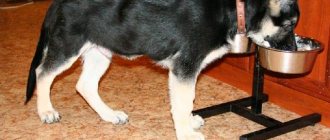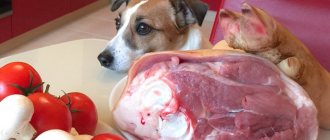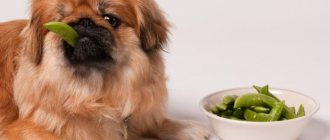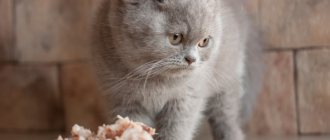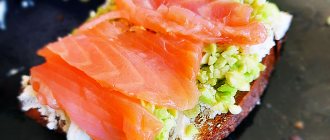The German Shepherd is called a symbol of bravery and courage. This dog is a faithful and at the same time dangerous friend of man. The character of the beast depends on its upbringing. If you are accustomed to affection and patience, your pet will become your most devoted and beloved friend. This breed is also easy to train. It will take a lot of patience to shelter this four-legged friend. He needs special care. An aspect of dog care is the question: What do German Shepherds eat? Not only friendliness, but also health depends on it.
German Shepherd nutrition, how and what to feed
The main rule that you need to learn when feeding your German Shepherd: the dog should not overeat. This point becomes especially important if the pet is active and jumps and runs a lot after eating. There are many side effects from eating too much. For example, obesity or atherosclerosis may begin, and your health will be unimportant.
The dangerous problem is that this breed is more prone to volvulus than others. Scientists zoologists explain this by the fact that the stomach organ in the body of the four-legged friend is too loose, it does not have precise attachment and is always in a “state of flight”.
For the health of the German Shepherd, it is important to establish the feeding process. To properly establish feeding, it is enough to follow a number of rules:
- eating at the same time every day;
- Food should be given only after the pet has taken a walk;
- if the dog has not had lunch 30–40 minutes after the walk, then it should be separated from the bowl until the next scheduled meal;
- choose one product and feed it every day, and introduce the remaining products into the diet gradually and intermittently, as additional nutrition.
conclusions
With a natural type of feeding, porridges occupy an important place in the diet - 25-40%. There is a large selection from their variety. NOT all cereals are equally healthy, and some can be harmful. How to prepare porridge for dogs depends on the grain chosen. A multicooker will significantly save your labor costs. Adding salt is not recommended, and sugar, spices, seasonings and flavor enhancers are completely prohibited. Vegetables are a good addition to the diet, but not all are beneficial to the animal. Porridge should be prepared for 1-2 meals, milk porridge only for 1 meal. Dogs that eat porridge are energetic, look healthy, and grow and develop well.
Experienced dog handlers know that there is no universal diet, proposing to take into account not only its calorie content and composition, but also the character of the dog and the stress it faces.
Excess fat is contraindicated for a phlegmatic person, a sanguine person needs proteins, a choleric person can easily master a large amount of carbohydrates. The pet walks a lot, which means it will easily burn extra calories. If you are busy with work, for example, on patrol, include carbohydrate and protein foods in the menu, removing fatty foods. Any emotional overload will also require carbohydrates. Organizing food for a German Shepherd is difficult only at first. Over time, the basic principles of diet formation will become clear to you:
- Proteins - up to 70%. This is meat pulp, freed from skin, bones and fat, as well as offal, cottage cheese, milk and eggs.
- Carbohydrates - up to 40%. These are slowly digestible cereals (porridges), as well as with healthy fiber and fast carbohydrates.
- Fats - from 20 to 40% (animal and vegetable).
Despite the strong opinion that protein foods are harmless, relying solely on proteins is prohibited.
Puppy diet
When a small German Shepherd puppy comes into the family, the owners are puzzled by the question of what the baby eats and what to feed the Shepherd puppy?
There is a difference in the nutrition of a small puppy and an adult.
If we are talking about a newly born puppy, then the main food for him will be mother's milk. It will attach itself to the mammary glands of a nursing dog 10–12 times a day.
It happens that the mother cannot feed the newborn for various reasons, then the owner will have to personally feed him from a pipette.
Mother's milk can be replaced with cow's or goat's milk, and it must be given through a pipette or bottle for newborns. The volume of milk should not exceed 2/3 cup daily, and the food temperature should not exceed 27 degrees.
When puppies reach two months of age, they need to receive all the important vitamins and minerals for healthy growth and development. It is important to control the intake of calcium into the baby’s body. Its excess can negatively affect health.
You also need to monitor your weight gain. The normal weight for a puppy is no more than 60% of the weight of an adult dog.
Natural nutrition should prevail in the diet; if the owner decides to switch the puppy to food or use a mixed diet, then it is necessary to choose food that has a certificate of the highest quality and is approved by leading veterinarians.
Choosing the right cookware
- First of all, you need to take care of your pet's bowl. It can be clay, metal, ceramic, plastic. The last option should be excluded; dishes of this kind fidget on the floor, not giving the pet the opportunity to eat normally.
- Small puppies often have loose legs, especially for those living in an apartment. Organize the feeding area based on the floor covering. If your home has laminate or linoleum, place a non-slip mat under your puppy's bowl. It can be fabric or silicone.
- It is known that at the age of up to one year, the puppy’s skeleton is just forming, as a result of which the frame is extremely fragile. For this reason, you need to place the bowl so that it is located at the level of your pet's neck or chest. Otherwise, during the period of growth, the puppy will constantly bend over, which will entail a curvature of the spine, a high raised croup, weak bones of the front legs and chest, problems with swallowing and digestive activity. You can adjust the height of the container using special stands, which are sold in all pet stores.
Features of feeding a puppy with natural products
When the owner weans the puppy from its mother's milk, he must decide what kind of food he will offer the animal in the future: natural or dry.
If the choice fell on natural food, then you should remember a number of rules for introducing complementary foods:
- the main thing is to gradually reduce the amount of milk consumed and introduce new products into the diet;
- you can start with milk porridge, boiled meat or boiled vegetables;
- It is allowed to feed the puppy both dry and natural food at the same time, the main thing is not to mix them at one time.
The number of servings at 3 months is 3-4 glasses of food, which should be given 5 times a day. When the pet reaches 6 months, it will need 1.5 liters of food 3 times a day.
How to prepare milk porridge for a puppy?
To the question of how to cook porridge for puppies, the logical answer comes - using milk. For 1 liter of milk we take 6 tablespoons of semolina. We boil the milk. To prevent it from burning, first rinse the pan with ice water. Pour the cereal into the boiled milk, stirring constantly, in a thin stream. Puppies are not allowed to add salt or sugar to their porridge. Cool to room temperature, the product is ready. You can check your temperature by applying the mixture to the back of your wrist. If it doesn’t bake, then you can feed it to little ones.
If you want to cook buckwheat porridge, then the proportion will be 1 to 4 with milk, you need to cook for 35 minutes. over low heat. But this is food for older puppies. It is not suitable for first feeding.
Rules for feeding a puppy dry food
When choosing dry food, you need to take into account the puppy’s age and taste preferences. To select the correct diet, the owner is recommended to visit a veterinarian with the pet. He will choose the right food. The food must meet quality standards and have special certificates confirming its benefits.
Food should be introduced gradually into the diet of a small puppy. First, it is recommended to soak the food in water until it becomes a paste.
At 6-10 months, the puppy can eat 1 full serving of food 3-4 times a day.
Age: 4-5 months
Starting from this period, the puppy needs to develop ligaments and joints. Also at this stage, teeth change, as a result of which the basis of the diet should be foods rich in calcium. The dog is still fed 4 times a day, keeping the serving size to 300-400 g.
- Changing teeth weakens the cartilage tissue, so your pet's ears may not rise. To promote full development, add collagen to your food. It can be found in confectionery gelatin or topical dietary supplements (for dogs).
- At four months of age, puppies are intensively developing their skeleton, in particular their posture. To help the body and lay the foundation for full development, gradually introduce chondoprotectors into your food. They are sold in pet stores, the main thing is to strictly follow the instructions and do not increase the quantity without permission. An alternative to the drug is Arthra, which can be purchased at a pharmacy.
- As for the basic nutrition, it remains the same (cottage cheese, meat, porridge, vegetables and fruits). However, now you need to feed the puppy not boiled meat, but beef tenderloin from the head. It contains a large amount of gelatin, which has a beneficial effect on the formation of the skeleton.
- You can prepare broth based on beef, veal, chicken, and then season meat porridge with it. But you shouldn’t make it too rich, so as not to burden the pancreas. The broth can be replaced with edible gelatin: dissolve it in water and stir into food (cottage cheese, porridge, mixed vegetables).
- To help speed up the replacement of baby teeth with molars, give your pet brain bones. It is also worth focusing on calcined additives marked “puppy”; pet stores sell a special series for German shepherds. If you have difficulty choosing, consult your veterinarian.
The principle of feeding an adult dog
The diet of an adult German Shepherd should include the following nutrients: carbohydrates, which help maintain the pet’s energy; proteins help maintain the tone of the dog’s entire body, and for vigor and good health it is necessary that vitamins enter the body along with food.
Currently, veterinarians do not have a clear answer as to what is the best way to feed your pet. Some people prefer dry food, while others believe that it is better for the animal to extract beneficial properties from food.
Age: 6-12 months
Once the puppy reaches six months of age, you can prepare porridge not only from pure meat, but also from offal (heart, liver, stomach). You should not give your dog thin bones; strong teeth will easily gnaw them, and the fragments will fall into the esophagus. Puppies 6-12 months old should have three meals a day, serving sizes vary from 350 to 450 g.
- At the same time, every month you need to reduce the amount of cottage cheese eaten for breakfast, and at the same time increase the amount of meat. If you are a cable owner, remove milk from your puppy's diet completely. In the case of females, the product is given daily.
- At this stage, the puppy’s owner needs to add active minerals, chondroprotectors, calcium and other vitamins, based on the weight and age of the pet. Don’t forget about vegetables and fruits; feed them to your puppy between main meals.
- To diversify your diet with cereals as much as possible, you can add buckwheat, millet, and millet to the existing rice and oatmeal. Combine them with each other, mix in raw or boiled meat/offal. Break a raw egg (sometimes a chicken egg can be replaced with a quail egg, doubling the quantity).
- It is allowed to give the puppy sea or river fish 2 times a week. However, these days you should not feed your pet meat. You should not overuse fish, as its composition destroys vitamin B in the dog’s body, which leads to digestive difficulties and stunted growth.
The basis of feeding a German Shepherd puppy is considered to be meat, cereals (except semolina), fresh or boiled vegetables and fruits. Don’t forget to pamper your pet with marrow bones, add food additives, gelatin, and calcium. Choose the right bowl and adjust the height of the stand. Follow a meal schedule, increase portions based on age, and walk more in the fresh air.
Feeding an adult dog natural food
If the owner prefers to feed his pet natural products, then he must adhere to several rules.
- All products must be of the highest quality;
- It is necessary to monitor expiration dates, especially for perishable products: meat or fermented milk dishes;
- Before cooking, you need to go through all stages of sanitation. If it is meat, then it needs to be washed and the veins removed. Fish meat should be removed from large bones;
- Food must be balanced and combine ingredients. For example, you should not combine meat intake with fruit.
When feeding natural products, a vitamin complex prescribed by a veterinarian must be added to the daily food diet.
Norms of cereals in the diet of dogs
Calculation of nutritional allowance depends on the size and weight of the dog, its age and state of health. The diet for special animals is prepared by a veterinarian, who also prescribes dosages. For healthy dogs, the daily portion size is calculated based on 3% of the total body weight. That is, if a pet weighs 10 kg, its daily portion of food should be 330-350 grams, food is divided into 2 meals.
Porridge should not exceed 25-30% of the diet. Accordingly, for a medium-sized dog you will need no more than 100 grams of cereal per day.
Feeding an adult dog dry food
Feeding your pet dry food also has a number of advantages. For example, this type of food can be stored for a long time without losing its beneficial properties. You can take the food with you in a package. Many owners take it with them for a walk or when they go to visit. Even for a large pet, a small amount of food will be enough for one meal.
There are several types of feed. For example:
- the economy option provides a high fiber content, and also lacks important microelements and vitamins;
- The premium food category is of high quality. The composition contains a combination of meat and plant components, and the best varieties are called super premium. They are high in cost and it justifies itself. These foods are rich in vitamins and minerals. The highest class products are used for production. They can be purchased in specialized stores.
What cereals are prohibited
Not all grains are good for a dog's body. Some cause severe allergic reactions or are not absorbed by the digestive system. The following porridges are prohibited:
- Barley is rich in vitamins and microelements, but the dog’s body is not able to absorb them, which makes eating this porridge absolutely useless. Pearl barley is produced by grinding the barley; this greatly complicates its digestion and ultimately leads to constipation.
- Millet porridge is a product that causes allergic reactions. In addition, millet is difficult to digest and its energy value is not beneficial.
- Corn grits can cause a false feeling of fullness in your pet. Corn also contributes to the development of various gastrointestinal diseases and allergies.
- Semolina porridge contains fast carbohydrates. This feature of the composition leads to a sharp weight gain in animals. Its use may be due to dystrophy or slow growth in puppies. In other cases, including semolina in the diet will not be beneficial, especially for dogs with diabetes.
What to include in a natural diet
Natural food, of course, will be healthier than buying dry food. The main disadvantage is the large amount of time it takes to prepare natural food for your pet. The advantage is that German Shepherds do not require a varied diet, however, you need to monitor the quality of dog dishes and the presence of useful elements in them.
The main dish for a pet is meat. You can give your dog any kind of food except pork. Minced meat is prohibited because it is poorly digestible. Fish should also be present in your daily diet. It is important to ensure that the product does not contain large bones that could cause the animal to choke. It is possible to give eggs, mainly the yolk.
And German shepherds are delighted with fermented milk products. They will be happy to drink kefir, milk or fermented baked milk. You can include fruits and vegetables in your pet’s diet, depending on preferences. Some dogs enjoy eating grains. Their consumption also needs to be limited.
Cooking features
All grains must be washed before cooking.
To save time, you can cook porridge for your German Shepherd in a pressure cooker, which will not only quickly cook the cereal, but also retain the maximum amount of nutrients. When preparing porridge, you can also add vegetables cut into layers into the pressure cooker: carrots, pumpkin, beets.
Once the optimal cereals and suitable meat have been selected, you can prepare the porridge itself:
- First, boil the meat. It is better to put it in boiling water, then it will retain the maximum amount of nutrients and vitamins. It is better not to salt the water at all. Chicken necks cook the fastest; beef and pork will take longer (at least an hour).
- After cooking, the meat must be cooled and cut into small cubes. Large pieces of meat may not be digested if the dog is very hungry and attacks the food.
- The cereal is placed in already boiling water or broth; you can immediately add diced carrots - this vegetable will not lose its beneficial properties even after prolonged heat treatment.
- The porridge needs to be stirred constantly. It is important to remember that it takes longer to prepare for dogs than for humans.
- After cooking, the porridge for the German Shepherd should sit covered for half an hour.
When all the ingredients are ready, you just need to mix the meat with the porridge and give it to your pet.
Meat and offal
Meat is one of the most important components in the natural feeding of an adult shepherd dog. The most valuable is the muscle tissue of meat. It is she who works on myosin and actin, which are needed for the full development of the pet. These proteins are perfectly balanced in amino acid content. Connective tissues are less valued. Especially collagen and elastin. Meat also contains beneficial B vitamins, and it also contains vitamin E. Since meat is rich in protein, it can provide your pet with strength and energy.
Depending on the shepherd’s preferences, meat can be given either raw or boiled. It's very easy to prepare. It is enough to boil a whole piece in cold water and cut into square pieces. If we are talking about raw meat, then before serving it is necessary to rinse it well under running clean water. It is preferable to feed German Shepherds veal, beef, chicken or turkey. Pork is prohibited. It is also not recommended to feed your pet minced meat, as it is poorly absorbed in the body.
Cereals
A German Shepherd's diet may also include porridge. The technology for preparing cereals is typical. Usually the product is sifted or washed and then cooked until cooked. The best cereals for dogs are buckwheat and rice. They contain many useful elements, for example, buckwheat is rich in iron, and rice helps strengthen the digestive system and saturates the bird’s body with B vitamins. Oatmeal takes second place in the list of favorite cereals. It will be easy for your dog to eat porridge and at the same time receive a dose of unique amino acids, proteins and fats. To avoid allergies and make sure that the porridge has “taken root”, it is necessary to give one type for several days.
Many pets love an assortment of several types. There are oatmeal lovers. It must be introduced into the diet carefully. This porridge causes indigestion attacks in our four-legged friends more than others.
Cook porridge in water. If your German Shepherd refuses to eat, then you should try giving Hercules flakes, which you can simply add water and wait for them to swell.
Cooking at home
You can get the maximum benefit from natural nutrition only if the food is fresh. Meat broths should not be stored for more than two days. Most porridges lose their taste after cooling and are more difficult to digest. Therefore, regardless of the type of cereal, it is better to prepare meat porridge for your dog immediately before consumption. You should also pay attention to the following recommendations:
- You can improve the properties of buckwheat by soaking it for 20 minutes in cold water before cooking;
- polished rice or eggs stick together less when adding a small amount of vegetable oil;
- oats can be added to the main grain; 2-3 spoons are enough per serving;
- porridge with milk is poorly digestible; water or meat broth will replace it;
- You cannot give raw meat and ready-made porridge at the same time, this will cause fermentation in the dog’s stomach;
- The animal's food container must have a hermetically sealed lid.
Compliance with the standards for storing and preparing natural food for dogs will prevent the loss of microelements and will delight your pet with excellent taste.
Vegetables
An adult shepherd can be fed vegetables. The opinions of veterinarians are still divided. Some say that feeding your pet vegetables is not worth it and this has a bad effect on the functioning of the gastrointestinal tract. Others argue that if the pet does not object to this food and there are no negative consequences for a long time, then it is possible.
Vegetables themselves are rich in vitamins of various groups. Fruits also contain a large amount of pectin, which allows you to remove heavy metals from the body and get rid of excess cholesterol. Vegetables can be given to your pet either raw or boiled. You only need to exclude fried processing. Shepherds especially love stewed or boiled cabbage, raw carrots and boiled beets. If the owner prefers to give vegetables and make sure that the pet receives vitamins directly from the products, then he can grate the vegetables on a coarse grater and present his four-legged friend with a salad.
General recommendations
Any dog is not only a predator, but also a scavenger . Puppies in nature gain independence by 4–5 months, receiving mostly leftovers after a successful pack hunt. And these are not fillet pieces, but cartilage/bones and connective tissue that help animals grow.
Domestic dogs are pampered with chicken breasts, fillets and tenderloins, which contain a lot of extra amino acids that are harmful to the dog’s body: they are poorly digested or stored as fat, and sometimes provoke allergies (protein poisoning). The tender pulp contains almost no building materials for the formation of bones, joints and ligaments, which is why first-class meat should be replaced by offal and trimmings with cartilage, veins and even skin particles.
Important! Don’t be afraid to feed your puppy raw meat because of the risk of infection with Giardia, Salmonella, viruses, roundworms, etc. A dog's stomach juice neutralizes not only pathogenic microflora, but also cadaveric poison. You should also not be afraid of antibiotics and hormones, which are occasionally found in meat: these are extremely unstable compounds that have time to decompose before it gets into the bowl.
In the wild, the puppies get their own food, and until they learn how to do this, they live from hand to mouth, content with what the adult tribesmen leave. If you're lucky, the puppy eats the carrion, as often happens in a wolf pack: the younger ones find what the older ones have hidden. Along with rotten game, growing dogs get rodents, lizards and insects (if they catch them), as well as berries, roots, carrion and manure.
Ready food or natural food
When thinking about what to feed your German Shepherd puppy, choose BARF, which normalizes the gastrointestinal microflora responsible for immunity. Dogs fed porridge with boiled chicken or fed industrial food have a noticeably weaker immune system. By the way, a menu where carbohydrates predominate not only changes metabolism, but also has a bad effect on the dog’s nervous system, increasing inhibition processes. It is not surprising that a puppy placed on BARF becomes more energetic and even aggressive.
This is typical for a growing organism receiving proper nutrition . You just need to increase the time for walking and playing. Puppies, as a rule, willingly eat raw foods, but sometimes become capricious, refusing unfamiliar ones. In this case, a new ingredient is mixed into the tested one or a slice is placed in the mouth and closed, waiting for the puppy to swallow.
This is interesting! A healthy puppy (due to rapid growth and an undeveloped satiety center) is always hungry, and refusal to eat signals illness or overfeeding. In the second case, he is separated from the bowl for a couple of feedings or the ration is reduced by 1.5–2 times.
A German Shepherd puppy with a natural diet receives all trace elements/vitamins from fresh chopped vegetables/fruits (plus berries/greens) and raw meat products. Industrial vitamins, especially water-soluble ones, are highly undesirable as they are easy to overdose on. If you consider it necessary to feed your puppy with them, give half the dose, adhering to the course interval.
Pedigree feed lines
Let’s assume that when answering the question of what to feed your German Shepherd puppy, you leaned toward ready-made factory food (due to your own laziness, being busy at work, or simple irresponsibility). You will have to choose a commercial diet with all seriousness, remembering that your puppy’s bone structure continues to form, which means that economy and premium food stuffed with grains is contraindicated for him.
Holistic products under the Acana and Orijen brands (with high nutritional value and good meat content) occupy the first positions in the domestic ranking of ready-made feeds.
The following foods are recommended for puppies:
- Acana Puppy Large breed;
- Innova Puppy Dry Puppy Food;
- Orijen Puppy Large;
- Acana Puppy Small Breed;
- Nutro Ultra Holistic Puppy;
- Chicken Soup For The Puppy Lover's Soul;
- Innova Large Breed Puppy Dry.
Important! If raw cartilage and bones are not on your pet's menu, you will need to supplement the diet with calcium supplements (preferably in the form of calcium chelate/citrate). Dog breeders appreciated Welpenkalk (Canina) and Irish Cal (Beaphar).
What not to feed German Shepherd puppies
The udder, lung, and especially beef liver, which often causes diarrhea, are prohibited.
The following are also recognized as dangerous and unnecessary products:
- bones after heat treatment and tubular;
- bread, pastry and sweets;
- fried foods;
- spices and herbs;
- legumes and cabbage;
- plum and grapes;
- ketchup and mayonnaise.
From 1 to 2 months, a German Shepherd puppy is fed 5-6 times a day every 3-4 hours (with a break for sleep), increasing portions as the pet grows . From 2 months they switch to 3-4 meals a day, from 3 months they feed three times a day. From six months onwards, the feeding regimen resembles that of an adult (twice a day), with the proportion of animal proteins reduced to 3–5% of the shepherd’s weight. Remember that overfeeding (overloading undeveloped ligaments/joints) is harmful for puppies, which causes dogs to become raw and loose.
Checking your puppy for allergies
A considerable part of breeders are convinced that German Shepherd puppies from 4 to 8 months should be fed extremely moderately, observing specific requirements for protein components.
Otherwise, the program designed by nature fails, and the owner raises a dog that is poorly adapted to life, with low immunity and susceptible to allergic reactions (including food ones). If your puppy’s diet is as varied as possible, that’s great, but the downside of a rich menu is intolerance to one of the ingredients.
Important! To understand what product the body rejects, you need to keep your shepherd dog on an elimination diet. At the same time, you will figure out whether the irritant is really in the food: perhaps the allergy is associated with other factors.
There are several types of such diets, designed both for puppies who are accustomed to dry food, and for their peers who specialize in a raw food diet. Adherents of natural feeding identify food irritants according to the following scheme:
- For a month, the puppy is given one unfamiliar type of meat (lamb, venison, fish, etc.), adding a single carbohydrate side dish (rice, potatoes, rolled oats).
- In case of a normal reaction, a new ingredient is introduced every 1–1.5 weeks; if an undesirable reaction occurs, the product is excluded, waiting for the symptoms to subside.
- So, step by step, month after month, they build up a dog diet that is guaranteed to protect the puppy from allergic manifestations.
Fans of dry industrial diets should follow a similar algorithm, only using food with hydrolyzate for their shepherd dogs, where the proteins are crushed and practically digested. Hydrolysis transforms protein components almost into a related organism: it ceases to identify them as foreign and does not give an allergic reaction.
Many companies produce products with hydrolyzate, so choosing a safe diet is not a problem. However, we must take into account that these foods contain not only protein components (soy, chicken), but also many additives. This is why food with hydrolyzate cannot be considered a panacea: they are also introduced into the diet gradually, observing how the pet reacts.
In addition, with any elimination diet it is prohibited:
- feed with treats during training;
- allow eating food found on the street (if the puppy does not understand, put a muzzle on him);
- arrange snacks and give supplements to the norm;
- treat with pieces from the master's table;
- change your dog's cosmetics.
Return to content
Fish and seafood
In terms of its composition, fish is in no way inferior to meat in terms of the presence of nutrients. It contains a large amount of proteins, fats and mineral salts. There is especially a lot of phosphorus and iron in fish and seafood. Fish contains fluoride and is rich in iodine. Meotinin distinguishes the protein content of fish from meat. It is also customary to divide fish according to the amount of fat it contains. There are lean varieties, for example, pollock or cod; moderately fatty fish containing up to 3% fat (sprat, tuna) and fatty fish (mackerel, halibut). Fish oils burn out very quickly in the body and are very beneficial for the dog’s immunity. German Shepherds prefer seaweed when it comes to seafood. There are several thousand varieties of them. All of them are enriched with mineral salts and vitamins.
It is recommended to give your dog boiled fish.
Is it possible to add sugar to dog dishes? Do I need to add salt?
Sugar is a valuable product; the body can release a large amount of energy from it. But it is strictly contraindicated for dogs. Their liver and pancreas are capable of processing glucose, but in extremely small quantities. Excess will cause problems. Dandruff will appear and your eyes will start to run. Very often otitis of unknown etiology and redness of the ears appear. With constant use of sugar, it will begin to act as an allergen. But everything is individual.
The dog receives salt in sufficient quantities from food, provided that the owner provides it with a high-quality diet, whether it be a natural type of feeding or industrial food.
Salt plays an important role in the body's metabolism. The functioning of the heart, the secretion of gastric juice and the functioning of the gastrointestinal tract and nervous system depend on it.
If you add this product to your diet on your own, an overdose with negative consequences is likely. Chronic salt poisoning will lead to death. The lethal dose is 3 g per kilogram of body weight.
A constant excess of salt will lead to urolithiasis, gastrointestinal upset, and metabolic disorders.
With proper nutrition, the dog will receive the required amount of salt, which is contained in the foods it eats: Is porridge given to dogs extra salt? No.
Manna
Semolina is used for primary feeding of puppies, as well as for the treatment and prevention of dogs with gastrointestinal disorders and other diseases. The nutritional properties are unsatisfactory and as a main grain it is contraindicated.
Pearl barley
Pearl barley is not suitable as the main grain in the diet, since it is extremely poorly digestible and often comes out practically undigested. Its nutritional value is unsatisfactory. Even large and giant dogs do not digest it well. With constant feeding, gastrointestinal problems arise, including blockage. Especially if this cereal is not cooked.
Corn
Cannot be used as a staple in the diet. It contains a lot of protein - 3.27 g and fat - 1.35 per 100 g. Dogs will begin to gain weight quickly, this will lead to obesity. The musculoskeletal system will begin to fail. There will be a risk of joint dysplasia, and the spine may begin to sag. This is especially dangerous if the animal does not walk much and does not receive enough physical activity. This cereal is suitable only as an additive to stimulate growth - 10-15% of the diet.
From peas and legumes
None of these grains can be used either as the basis of a dog's diet or as a supplement. They are harmful. The consequence of their use is gastrointestinal upset, flatulence and colic. This occurs due to the fermentation processes that these products cause in the digestive tract.
Millet
When cooked poorly, cereals are poorly digestible and may come out almost unchanged. Can lead to gastrointestinal upset and blockage in case of constant feeding. But when cooked correctly, it is very nutritious - 385 calories. per 100 g. It is also hypoallergenic.
Dairy products
Fermented milk products are enriched with all useful elements. There are minerals, fats, and proteins. German Shepherds prefer milk from all the fermented milk world. You can give goat, or you can give cow. It all depends on the pet’s taste choice.
These products also contain a certain amount of sugar, which is called milk sugar. It is not recommended to abuse it. Under the influence of lactic acid bacteria, lactose begins to ferment in the product and the result is kefir, yogurt, and fermented baked milk. They are also beneficial for your German Shepherd, just like milk. Lactic acid products are especially useful for puppies. Adult dogs should be given it with caution. The fact is that milk can cause stomach upset in four-legged friends. Then veterinarians advise switching to fermented milk products. There is a category of dairy-protein products, these include cottage cheese and cheese. This is the German Shepherd's favorite treat.
What cereals can you feed your dog?
Not all grains are recommended for dogs as food on an ongoing basis. Some should be treated with caution, due to possible allergic reactions or individual intolerance.
- Rice porridge is suitable for daily consumption by all breeds of dogs. It contains vitamins E and group B, as well as zinc, iron, magnesium, and potassium. In addition to the undoubted benefits of microelements, rice has an absorbent effect. Its decoction will help with a dog's stomach upset, diarrhea and poisoning.
Expert opinion
Anna Abramenko
An avid dog lover. Experience in veterinary medicine since 2009.
Ask a Question
Preference should be given to unpolished types of rice; they contain more protein and lipids. This type of cereal contains less starch and is easier to digest, it does not contain gluten, and it is considered hypoallergenic.
Excessive consumption of rice cereal by a dog can cause constipation. You can avoid this by combining several cereals.
- Buckwheat porridge is rich in iron and magnesium, vitamins B and E and other microelements. It is easily digestible and suitable for large breeds or sedentary dogs. Regular consumption of buckwheat speeds up metabolism and strengthens the immune system. For animals with problems with the cardiovascular system, it is necessary to introduce it into the diet. This porridge is recommended to be given to puppies and pregnant dogs.
- Wheat porridge is considered a natural scrub for the intestines. Due to incompletely digested particles, it removes food debris from the walls. The starch content makes it contraindicated for dogs prone to gaining excess weight.
- Yachka combines high nutritional content and economical efficiency. Barley contains silicon and fluorine. But the amount of microelements is low, insufficient for complete nutrition of a healthy dog. Yachka is not suitable for the daily diet.
- Oatmeal often causes allergic reactions, so it should be administered with caution. It is recommended to start feeding your dog oatmeal with small portions and carefully monitor its condition. The reaction is expressed in intense scratching of various parts of the body, redness and rashes. You should also use oats, not rolled oats.
When preparing natural food, it is recommended to mix different types of cereals. This will expand the list of vitamins and microelements in their composition. You should not give preference to any one of the porridges; a dog’s complete diet requires variety.
?
How to choose dry food
If the owner loves and appreciates his pet, then he will feed him with middle or high-class varieties of dry food. These categories contain premium products, they are enriched with vitamins and minerals (which are not in the economy version), and most of them consist of meat. The food is literally full of protein. In economy class varieties, many low-quality manufacturers add a meat additive instead of meat, which is similar in taste, but no longer contains the nutrients that a dog needs to receive daily.
This food costs several times less than middle or high class food.
Important: you cannot save on the maintenance of animals; if a person has already taken responsibility for a German shepherd, then he must do everything for its health and well-being.
How to cook porridge correctly?
Cereals can be cooked either in the classic way in a saucepan over a fire, or in a slow cooker. The second method will save your time, and the porridge will be more fluffy and nutritious. Here are some porridge recipes for dogs.
On the water
For 1 required volume of porridge we take 2.5-3 volumes of water. Pour the cereal into boiling water and cook for 20-30 minutes. The finished porridge should be soft and as fluffy as possible. It is important to ensure that the porridge does not burn or boil over. If necessary, reduce the gas or add water.
In a multicooker, the proportions are the same, plus you can choose a specific program.
Is it worth cooking with broth or milk?
Broth makes porridge tastier and healthier. Dogs are more willing to eat it. Maximum nutrients get into the feed. In this case, the meat or offal is boiled in the volume of water that will later be needed to prepare the porridge. It is important to collect the resulting foam. If the broth has boiled away, then boiled water is added to the desired level. The broth can also be prepared from large bones, the fat will be quite decent. The proportions remain the same as on water.
Milk contains large amounts of lactose. This compound is easily broken down by puppies, but adults may experience problems with the gastrointestinal tract. It is worth cooking semolina porridge with milk for the primary feeding of young animals. Such porridges are contraindicated for adults and can only be consumed for medicinal purposes. If there are no problems with milk, then it can be given raw (preferably homemade). Goat milk is safer, but also more expensive and is not available everywhere.
Combined nutrition
Combination nutrition is the combination of dry food with natural food. It is recommended to give different types of food at strictly defined times. This type of nutrition requires careful daily observation of the work of the shepherd’s digestion. Many owners consider this type of feeding very problematic and not justifiable. It is very difficult to determine which beneficial substances have entered the animal’s body and which have not.
Summing up
- Porridge is an important part of a puppy's diet.
- Buckwheat, rice and oatmeal cereals are most suitable for puppies.
- Bowls with food and water should be placed at chest level so that the puppy does not have to bend over while eating and drinking.
- High physical activity should be developed no earlier than after 1-2 hours.
- The puppy’s diet should be varied and complete; one food cannot be replaced with another to the detriment of nutritional value and vitamins.
- Food should always be warm and fresh.
- It is important to know which foods can be consumed by puppies, which by adult dogs, and which should not be included in the diet at all.
- It is necessary to ensure that the puppy does not remain hungry or overeat.
- Your puppy should always have access to clean, fresh water.
So, after reading this article, you can now determine what and how to feed your little four-legged friend so that he grows up healthy and cheerful. And surely you have your own personal experience and opinion that you would like to share, your stories and photos of your pets? We are waiting for your comments.
List of prohibited products
There are foods that you absolutely cannot feed your German Shepherd to avoid health problems. Here are the top most harmful foods for this dog:
- Garlic and onion. It should not be given either boiled or raw. If a significant amount of this product gets into your pet's food, it can cause poisoning. You can tell what a four-legged friend is like by his behavior - he will be lethargic and lazy.
- Chocolate. The caffeine contained in the product can be a deadly poison for a shepherd.
- Avocado. For comparison, an avocado is to a German Shepherd what a puffer fish is to a human.
- Boiled bone. The bone itself is not dangerous in its composition. But if your pet bites off a part and a splinter gets into his throat, then you need to sound the alarm and go to the veterinarian. Once in the intestines, such a fragment will not be digested and the animal will experience intestinal volvulus.
- Raw fish. This product will only become dangerous in its raw form. It can cause severe poisoning. When this happens, the dog will develop a fever and severe vomiting. If you do not seek help in time, death may occur.
- Liver. It should not be presented to the dog table too often. Since the liver contains vitamin A, this product can be dangerous for the skeletal system of four-legged animals. It is known that this vitamin cannot fully double in the body of a German Shepherd.
The ratio of cereals and additives. How much per day to give?
The portion is calculated according to the age and weight of the puppy, and then it is monitored whether he is full or not. If the pet willingly ate everything and licked the bowl, next time increase the amount of food given. Some animals do not leave anything, even when they are full, you should not allow them to overeat.
The total amount of food per day is 5% of the puppy’s weight; at the age of up to 4 months, another 100 g is added for 1 month of life.
- 1-2 months: cereals and vegetables should make up 10% of the food volume.
- 2-3 months: 15-25% cereals and vegetables, 35-50% meat and 40-50% dairy products.
- from 4 months: meat consumption increases, and other products decreases: the diet consists of 10-15% of cereals and vegetables, 25-50% of dairy products and 50-70% of meat.
Increasing the ratio of one at the expense of the other is inappropriate, including for the purpose of saving.
The amount of meat is calculated based on the requirement of 20-30 g per day per kg of puppy weight. Twice a week, instead of meat, fish should be given, 40-60 g per kg of weight.
Per 1 kg of weight:
- 1.5 g fiber
- 9 g protein
- 13.8 g carbohydrates
- 2.64 g fatty acids.
A third of the daily meat ration is added to the porridge; the rest should be fed raw.
The cooking ratio is:
- 30% cereals
- 40% meat, meat by-products or fish
- 30% vegetables and feed additives.
If it so happens that a feeding was missed, during the next feeding the usual portion is given, without additives. The same applies to the temporary replacement of some products with others. If at some time your pet is given meat porridge instead of milk, there is no need to then try to make up for the missed meal with additional portions or “replace it the other way around”: you should just continue to feed it as before.
IMPORTANT ! The puppy must have fresh water at any time of the day.
Vitamins
There are 2 large groups of vitamins that should enter the body of a German Shepherd every day. The first group is fat-soluble vitamins; they always accumulate in the body and are stored “in reserve.” This type includes vitamins A, D, E. The second category is water-soluble vitamins. They dissolve in the body every day, and if there is an excess, they are excreted in the urine. In total, 12 vitamins should enter the animal’s body, which will help normalize the body’s functioning. If a dog has a lack of vitamins, this will affect not only its health, but also its appearance. The fur will shed, the claws will break, for example.
Depending on the breed
German Shepherd
Porridge should make up 25-35% of the total diet. You can give buckwheat, rice and oatmeal porridge. They are usually supplemented with meat and vegetables.
Mom-Dad, thank you for the delicious porridge!
Husky
Steam oatmeal flakes with boiling water and let steep for 10 minutes. It is not recommended to give oatmeal often, because... it weakens, but can easily be replaced with rice or buckwheat. Add raw yolk, a little raw minced meat and cottage cheese - voila, breakfast is ready!
Malamute and Husky: 12 differences with clear photos
Labrador
The following recipe is useful for Labrador puppies: steam finely ground oatmeal with milk, add 1 tsp. fish oil and 2 glucose tablets. You can also cook buckwheat with meat in vegetable broth.
“Can I have some more porridge?”
Devoted friends Golden Retriever and Labrador: 5 differences
York
For Yorkies (as well as Shitzus, toy terriers and pugs), oatmeal and semolina are unacceptable, because... These dogs are prone to obesity. To prepare a delicious porridge for your Yorkie, take a small carrot, a little cauliflower, and 2 tablespoons of buckwheat. Cook everything until tender (about 30 minutes), then mix the resulting dish with a blender, add a little unrefined vegetable oil, boiled beef or chicken and serve the porridge to the dog. There should be no salt and pepper!
Calculate a serving of cooked porridge as follows: 500 grams. pet's weight - 1 tablespoon of porridge.
Reviews
Oleg Romanov, Nizhny Novgorod
“We have a 9 month old German/Eastern Shepherd mix. We always cooked porridge with meat for her, but in the summer season we move to the dacha and there is no such opportunity there anymore. Therefore, every season he switches to dry food. Problems with the gastrointestinal tract were usually not observed, and the color of the stool occasionally changed. It might be worth trying to make the transition more smoothly.”
Maria, Moscow
“I noticed that from the age of three months my German baby began to itch a lot. I fed her according to all the rules: chicken broth, rice, buckwheat, millet, wheat, beef, beef bones, minced dog, bread. But then she noticed that her mother-in-law occasionally tossed her sausage from the table, smoked meats, or pasta. We went to the vet and it turned out she had a food allergy! They prescribed a stricter diet and vitamin supplements to relieve intoxication. Now everything is fine, but I had an educational conversation with my mother-in-law on the topic of PP in German shepherds).”
Irina Alexandrova, Arkhangelskoye village
“This is what we feed our German Shepherd (5 months old):
In the morning, 350 grams of cottage cheese with kefir or yogurt. For lunch – 300 grams of rice, oatmeal or buckwheat porridge + 250 grams of beef + vegetables with a tablespoon of vegetable oil. Add vitamins in drops. In the evening for dinner everything is the same as for lunch, only without vitamins. We mix meat and vegetables, but put the porridge in a clean bowl so that it does not become saturated with the smell of other food. Dry food was never present in our diet. But we still use a lot of water because we have a private home and the dog spends a lot of time outdoors.”
Video
What grains cannot be cooked
Despite the benefits, some cereals should not be given to dogs or can be fed on a limited basis:
- Wheat provokes intestinal volvulus; you can give millet cereal to dogs, but not often.
- Corn should not be given in the form of cereals or canned food; it can be given raw or boiled.
- When talking about whether pearl barley is ok, you need to remember that it is an allergen and is practically not digestible. It is not recommended to give it.
- Semolina does not contain vitamins and other useful substances. It is allowed to give to newborn puppies only with the consent of a veterinarian.
These rules must be taken into account when creating your daily menu.
How to avoid dog obesity
Overweight in a German Shepherd is a serious and fairly frequently diagnosed disease that occurs when there is no control over the amount of food consumed. Excessive fatness not only contributes to the deterioration of the aesthetic appearance of a four-legged pet, but also poses a serious threat to the health of the animal.
The main causes of obesity include overfeeding, lack of physical activity, metabolic disorders, stress, genetic predisposition or hormonal imbalance, and even worms.
It is not always possible to combat excess weight in a dog with diet or increased physical activity. The lack of effectiveness of dietary nutrition and physical activity may require the prescription of drug therapy. In this case, veterinarians most often recommend using the drug Dirlotaride (Slentrol), which suppresses the animal’s appetite and prevents the absorption of fats. The veterinary drug Yarvitin has a similar effect, reducing hunger and activating metabolic processes.
It should be remembered that medications are considered as a last resort and are prescribed only by a veterinarian after a complete examination of the dog and identification of the factors that provoked obesity.
Return to content
